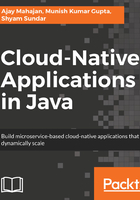
Going native
Once the enterprises start becoming comfortable with the IaaS, the next wave of adoption comes in terms of adoption of PaaS as part of the application workloads. In this stage, the enterprises start discovering services with the following benefits:
- Platform services replacement: This involves the identification of potential platform features of the enterprise, lifting and shifting the workload, and replacing it with equivalent platform services from the cloud provider. For example:
- Replacing application messaging systems with queuing systems provided by the cloud provider (such as AWS SQS)
- Replacing data stores or relational database management systems (RDMBS) with equivalent managed data services (such as AWS RDS)
- Replacing security or directory services with a managed directory or security services (such as AWS Directory and AWS IAM)
- These services allow the enterprise to do away with all the operational efforts, such as data store backup, availability, scalability, and redundancy, and replace them with a managed service that provides all these features
- Application services replacement: Enterprises discover new services that can replace their own platform or utility services. For example:
- Replacing build and release services or products with equivalent DevOps services from the cloud provider (such as AWS CodePipeline, AWS CodeCommit, or AWS CodeDeploy)
- Replacing application services or products with equivalent application platform services (such as AWS API Gateway, AWS SWF, and AWS SES)
- Replacing analytics workload services with equivalent application analytics services (such as AWS Data Pipeline and AWS EMR)
Once the applications start adopting the platform services, the applications start abstracting out features or functionalities provided by commercial off-the-shelf (COTS) products (such as messaging, notification, security, workflow, and API Gateway) and replacing them with equivalent feature platform services. For example, instead of hosting and running the messaging IaaS, movement to an equivalent platform service means moving to a model where you pay only for the number of messages sent, without incurring any additional operational costs. This model brings significant savings, as you move from renting and operating the product to a model where the product is rented only for the time it is utilized.